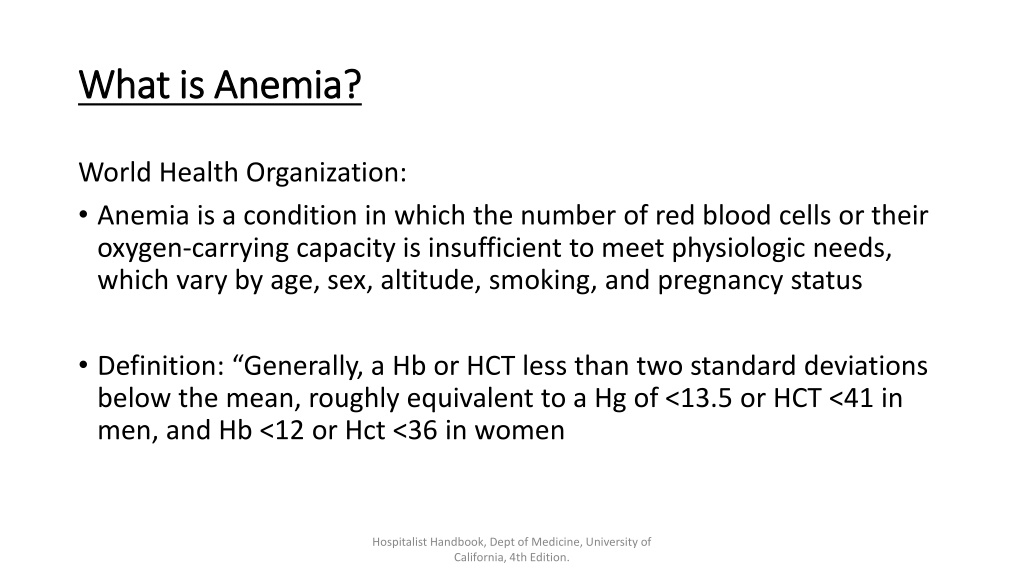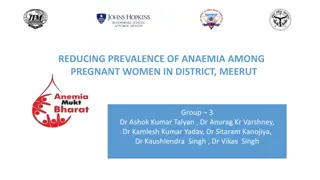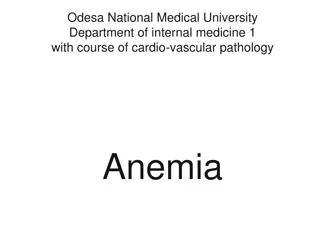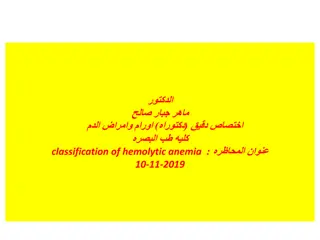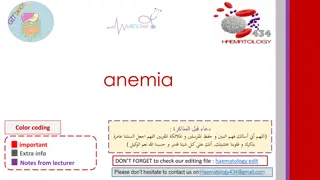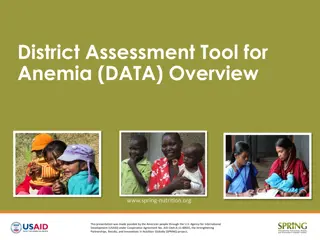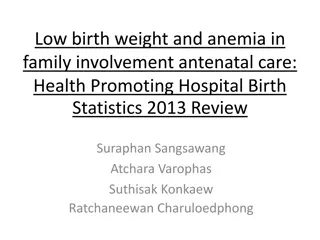Understanding Anemia: Causes, Mechanisms, and Classifications
Anemia is a condition characterized by a deficiency in red blood cells or their oxygen-carrying capacity, impacting physiological needs. Causes include blood loss, decreased production, and destruction of red blood cells. There are various classifications such as acute and chronic blood loss anemia, anemia due to chemotherapy, neoplastic disease, chronic kidney disease, and more. Patients may exhibit multiple types of anemia. Additionally, coding challenges may arise when documenting anemia post-surgery due to blood loss.
Download Presentation

Please find below an Image/Link to download the presentation.
The content on the website is provided AS IS for your information and personal use only. It may not be sold, licensed, or shared on other websites without obtaining consent from the author. Download presentation by click this link. If you encounter any issues during the download, it is possible that the publisher has removed the file from their server.
E N D
Presentation Transcript
What is Anemia? What is Anemia? World Health Organization: Anemia is a condition in which the number of red blood cells or their oxygen-carrying capacity is insufficient to meet physiologic needs, which vary by age, sex, altitude, smoking, and pregnancy status Definition: Generally, a Hb or HCT less than two standard deviations below the mean, roughly equivalent to a Hg of <13.5 or HCT <41 in men, and Hb <12 or Hct <36 in women Hospitalist Handbook, Dept of Medicine, University of California, 4th Edition.
Mechanisms Mechanisms Blood Loss Acute, Chronic, Acute on Chronic Decreased Production (Deficient Erythropoiesis) Iron Deficiency, Hypo proliferation in renal disease, Vitamin deficiency Destruction Sickle Cell, Trauma, Spherocytosis
Small Sample Small Sample - - Classifications Classifications Acute blood loss anemia Chronic blood loss anemia Anemia due to chemotherapy Anemia in neoplastic disease Anemia in chronic kidney disease Anemia in other chronic disease (please specify)* Iron deficiency anemia Anemia due to other nutritional deficiency (please specify)* Hemolytic anemia due to (please specify)* Other Cause of anemia (please specify)*
Blood Loss Blood Loss Blood Loss Anemia, Acute Drop in RBC proportional to severity of bleeding. Resultant anemia is normocytic. Chronic Blood Loss Anemia Hypochromic-microcytic Source: Hospitalist Handbook, Dept of Medicine, University of California, 4th Edition.
Patients May Have Multiple Types Patients May Have Multiple Types We may (and should) report as many types of anemia as are present, supported, and documented We may report, as an example, anemia due to ESRD as well as acute blood loss anemia
Coding Clinic, 2004, 3 Coding Clinic, 2004, 3rd rd Qtr Qtr Question: Our surgeons think that anemia due to an expected blood loss is integral to procedures. When we query the physician regarding patients whose lab values have dropped significantly after surgery to levels suggestive of anemia, the physicians are refusing to document anemia due to blood loss even if they monitor and transfuse the patient. They say the patients lost an expected amount of blood. I have read Coding Clinic, Second Quarter 1992, pp. 15-16 and its discussion of post-operative anemia guidelines. But this issue doesn t give us definitive information to give the physicians that clearly states, blood loss anemia due to an expected blood loss can be documented and reported when the patient meets the clinical criteria of anemia and the diagnosis meets UHDDS guidelines for reporting other diagnoses
Postoperative Anemia Postoperative Anemia Secondary to Expected Blood Loss Secondary to Expected Blood Loss Answer: Coders should not use blood transfusions or abnormal lab findings as definitive variables in determining whether or not to code blood loss anemia without physician documentation. If in the physician s clinical judgment, surgery results in an expected amount of blood loss and the physician does not describe the patient as having anemia or a complication of surgery, do not assign a code for the blood loss. This advice is consistent with information previously published in Coding Clinic, Second Quarter 1992, pages 15-16, and Third Quarter 2000, page 6.
Coding Clinic Does Not Define Diagnoses Coding Clinic Does Not Define Diagnoses
Myth: No transfusion = no code Myth: No transfusion = no code ICD-10-CM and ICD-10 PCS Coding Handbook, 2015, Nelly Leon-Chisen, RHIA, Central Office on ICD-10 and ICD-10-PCS of the AHA
Example: Clinical Evaluation Example: Clinical Evaluation 40 year old male presents with ICH, obtunded MRI reveals severe vasogenic edema and herniation of the brain Neurology determines patient can t be salvaged Placed on Comfort Care, expires shortly after admission What is coded? How might this principle be applied with Anemia?
Considerations for Acute Blood Loss Anemia Considerations for Acute Blood Loss Anemia Acknowledge the controversy Coordinate policy/strategy with Physician leaders, Compliance, CDI and HIM Leaders Common shared strategy CDI Team & Coding Team
ABLA ABLA How much blood loss is documented to have been lost intraoperatively and in recovery as recorded by I/O, Drains, saturated dressings? What does your staff consider a clinically significant loss of blood? Can you cite H/H before and after loss of significant blood loss was there a significant decline? Is a certain % defined as significant by your program? Does the patient have documented chronic anemia due to something such as ESRD, nutritional deficiency? Review for documentation of other pre-existing forms of anemia, consider referencing CBC profiles as these may be used to evaluate other factors causing anemia not associated with blood loss
Anemia Query (Background) Anemia Query (Background) 45 year-old male presents with hematemesis and RN staff record estimated blood loss in ED of 800cc in this patient with no PMH for anemia Exhibiting tachypnea and is orthostatic Hgb is 7.0 and 2 units PRBC transfused Serial CBCs indicate HgB improves to 9.0 after transfusion.
Anemia Query Anemia Query - -Continued Continued Please clarify the nature of the patient s hematological values and presentation Anemia due to Acute Blood Loss Anemia due to other cause Other Explanation of Clinical Findings Unable to Determine
3rd Quarter, 2019, pg 17 Question: A patient with melena and hematemesis was diagnosed with acute on chronic blood loss anemia due to a bleeding duodenal ulcer. ICD- 10-CM classifies acute blood loss anemia to code D62, Acute posthemorrhagic anemia, and chronic blood loss anemia to code D50.0, Iron deficiency anemia secondary to blood loss (chronic). An Excludes1 note for anemia due to chronic blood loss (D50.0) appears at code D62, and an Excludes1 note for acute posthemorrhagic anemia (D62) appears at code D50.0. What is the appropriate code assignment for documented acute on chronic blood loss anemia, when Excludes1 notes appear at both codes? Answer: In this case, assign code D62, Acute posthemorrhagic anemia, for the acute on chronic blood loss anemia. When acute and chronic blood loss anemia are both present, assign only a code for acute blood loss anemia.
Bleeding 2/2 Extrinsic Circulating Anticoagulants Bleeding 2/2 Extrinsic Circulating Anticoagulants Coding Clinic 1stQuarter 2016, pg.14 Coding Clinic 1stQuarter 2016, pg.14 Bleeding Caused by Extrinsic Circulating Anticoagulants Question: Should bleeding due to therapeutic anticoagulant be coded as a hemorrhagic disorder (category D68)? Answer: For the most part, hemorrhagic disorder or coagulation defects must be specifically diagnosed and documented by the provider, in order to assign codes at category D68, Other coagulation defects. However, for bleeding such as hemoptysis, hematuria, hematemesis, hematochezia, etc., that is associated with a drug, as part of anticoagulation therapy, assign code D68.32, Hemorrhagic disorder due to extrinsic circulating anticoagulants. This is supported by the inclusion term at D68.32 of Drug- induced hemorrhagic disorder. The sequencing of code D68.32 and other codes describing the type or site of bleeding, (e.g., hemoptysis or hematuria), would be dependent on the circumstances of the admission.
Example Example Progress Note 10/2/19 documents Melena and documents Apixaban is stopped 90 year old male with afib on Apixaban, and AV block s/p PPM last interrogated 8/7, and Parkinsonian features on Sinemet who presents with melena and then maroon stool. #Melena and Hematochezia: Ddx includes diverticular bleed based on reported endoscopic hx and may have started slowly and hastened, PUD although no abd pain, AVM/angioectasia, and/or malignancy. Hgb drifting down but HDS. --serial H/H and transfuse for Hgb goal >7 -agree with PPI BID -EGD/colonoscopy with 3:15pm Thurs -clear liquids until then -f/u iron studies (ordered for you) #Afib on Apixaban: PPM in place for rate control. -hold apixaban
Query Query Please clarify the association, if any, between these conditions: Melena & Apixaban An association between diagnoses may not be assumed and must be explicitly documented. You may answer this query by marking the checkbox(es) below or using free text at the ( * ) if appropriate. Provider Query Response:* Association exists No association exists Unable to determine Other (please specify)* The purpose of this query is to ensure accurate coding, severity of illness and risk of mortality compilation. When responding to this query, please exercise your independent professional judgment. The fact that a question is asked does not imply that any particular answer is desired or expected.
Related: Pancytopenia Related: Pancytopenia Intrinsic Lymphoma, MDS, Systemic Lupus, Malnutrition Extrinsic Drugs, Chemotherapy, Radiation High Dose Interleukin 2
